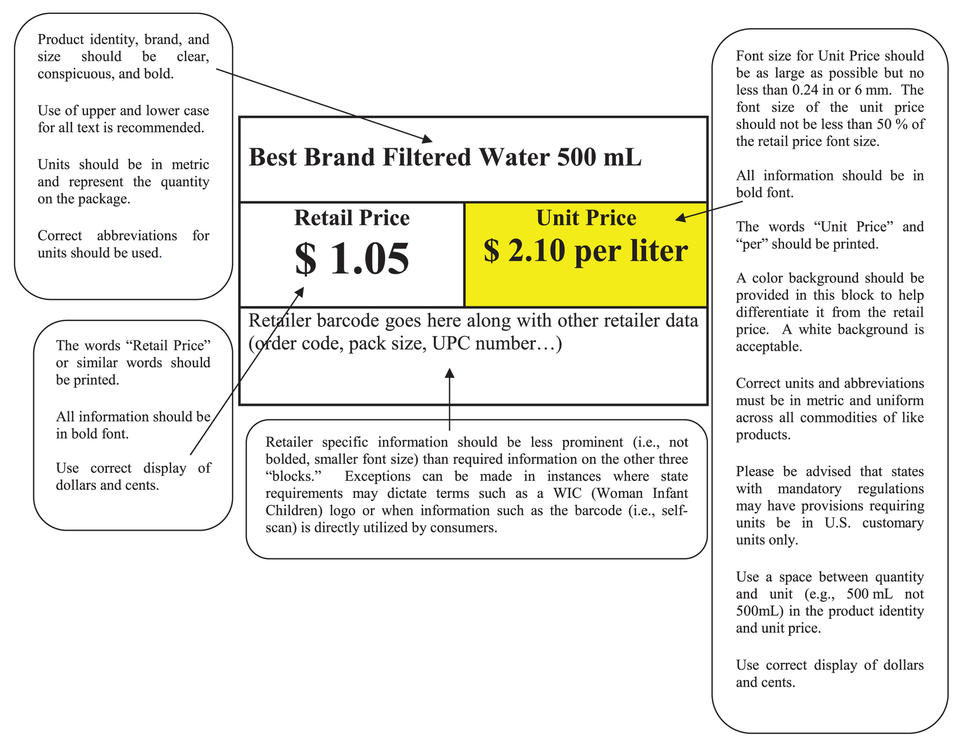Taking Measure
Just a Standard Blog

Checking the unit price labels at the local grocery store.
Believe it or not, I love to grocery shop. Besides getting to pick all my favorite foods, I love the challenge of getting the best deals—and a challenge it can sometimes be! Without a doubt, I have found that the best tool available to enable price and value comparison is unit pricing, you know, those shelf labels that provide the price per unit of measure. It’s especially helpful in today’s environments where “downsizing” of packages is a common practice.
Before I joined the Office of Weights and Measures at NIST, I worked in the supermarket industry. One of my responsibilities was to ensure price accuracy in our stores, including accurate unit pricing. Today, I’m a technical adviser with the NIST Laws and Metric Program in the area of legal metrology (metrology is the science of measurement). We work with regulatory officials, industry, trade associations, consumers and consumer groups on things like package and labeling requirements, weights and measures law, methods of sale for commodities, price verification, and, of course, unit pricing.
If you’re anything like me, you probably get frustrated with the unit pricing labels that some stores use. Some of the things I find a little vexing are having to read small print, not being able to locate information on the label easily, and especially when I see that the unit of measure being used for the unit price is not consistent across a product category. For example, all juices in the juice aisle should be priced by the same unit of measure, say the fluid ounce, yet you sometimes find some juices unit priced by the gallon, some by the pint, some by the quart and some by the fluid ounce. This makes price and value comparison really difficult! How can anyone compare, for example, a half-gallon of a brand-name apple juice priced at $1.35 a quart to the store brand when the store brand is priced at 4.2 cents per fluid ounce?
I don’t know about you, but I don’t think price-conscious shoppers should be asked to do a lot of complicated math when all they want to do is get the best value and go home.

Although unit pricing has been around since the early 1970s, its use is still voluntary in 41 states. If retailers in those states do decide to unit price, there’s little guidance on how it should be done, leaving us with a hodgepodge of approaches. Despite the lack of uniformity in how the information is presented and other flaws, the practice is pretty common in grocery stores throughout the nation. However, there are many other types of stores in various retail outlets, such as drug and convenience stores, mass merchandisers, wholesale clubs and auto parts stores, just to name a few, that do not unit price. Consumer Reports has helped bring national attention to the issue and opportunities regarding the display of information on unit price labels, and some retailers have made steps toward those goals since then, but there’s still a long way to go.
Back in July of 2011, I was fortunate to be able to participate in a technical session at the National Conference on Weights and Measures on opportunities to improve unit pricing. Following that technical session, I was asked to lead a collaborative workgroup, which included representatives from industry, trade associations, academia, weights and measures regulatory officials, consumer groups, consumer advocates and my office, to develop a unit pricing best practices guide. Our goal for the guide was to detail best practice principles that industry could use to improve the presentation, readability, accuracy, and usability of unit pricing information.
I’m proud to say that we succeeded.
Published in December 2014, the NIST Special Publication 1181 - Unit Pricing Guide “A Best Practice Approach to Unit Pricing” (PDF) is the first comprehensive guide for unit pricing labels. If you get the chance, you should give it a read. It’s maybe not a page-turner like Harry Potter, but it’s easy reading with lots of pictures and charts and has everything you need to know about the governing principles for prominence, legibility, clarity, consistency of units of measure, placement, contrast, text size and accuracy.
Then, when you’re shopping and find yourself frustrated because of shortcomings of the unit price labels or complete lack of them, you can pass along your newfound knowledge, and maybe even a link to the guide, to the store’s management.
If retailers took the time to take a look at this guide, I think they would be surprised by how making just a few simple changes could dramatically improve the shopping experience for their customers, like you. Now that’s what I call customer service!
About the author
Related Posts
Comments
- Reply





